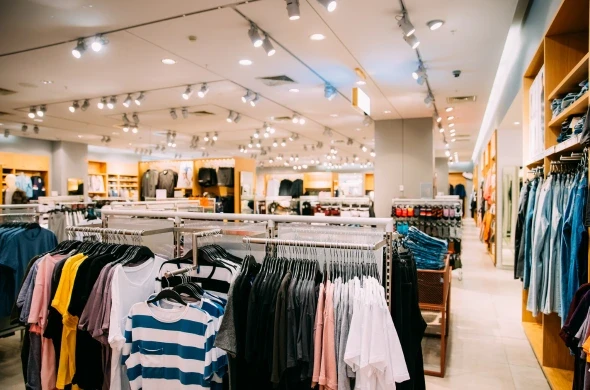The retail store layout involves more than setting up merchandise and displaying products. Planning the retail store layout also provides an opportunity to maximize sales by focusing on the store design and customer flow.
There’s a whole segment of research that is focused on consumer psychology, including how consumers navigate a retail store. The retail manager has the responsibility to manage the store in the best way possible - and retail design firms can play a valuable role in the process.
Once you’ve directed the consumer to your store, you need to guide them within it.
Let’s explore a few key retail store layout options and the pros and cons of each.
Grid Floor Plan
Also known as the straight layout, the grid floor plan is commonly used in grocery stores and works well with small businesses that sell to consumers who need convenience and efficiency.
Prioritizing visual merchandising, the grid floor plan makes use of light fixtures and runs displays along the wall to open up floor space. Consumers can easily walk through the aisles and find what they are looking for. For example, a consumer can step inside any of the eight Waitrose stores in Dubai and navigate effortlessly.
Pros of a Grid Floor Plan
There’s a reason that so many convenience stores use a grid plan, as it helps to meet the consumer needs in a quick and easy way while maximizing product display.
- Easy to navigate and find products easily
- Open aisles can accommodate high traffic flow
- Exposure to large shelves allows customers to browse
- Plenty of space to advertise, promote deals and display new products
Cons of a Grid Floor Plan
There are a few instances when a grid floor plan can be a con.
- The stock-standard design isn’t particularly innovative
- Failure to find a product where it’s expected to be can lead to frustrated consumers
Loop Floor Plan
The loop floor plan takes the customer on a guided experience, nudging them in the direction that you want them to follow. A combination of high perimeter walls and features in the middle of the floor shape the space like a race track and it can work for any business size.
Consider a shoe store and how the path that the customer takes is largely controlled. The walls are covered with shoe displays, and the middle of the floor has a seated section for trying on shoes. It’s also a great space to display promotions and children’s shoes.
Pros of a Loop Floor Plan
Research shows that consumers continue to make more in-store purchases despite the convenience of online shopping, and a loop floor plan makes the most of this behavior.
- Wall space is used for advertising and display
- Opportunity to showcase multiple products
- Offers an engaging customer experience
- Provides a friendly and relaxed atmosphere
Cons of a Loop Floor Plan
There are a few considerations to keep in mind when planning a loop floor plan.
- It can be challenging to consistently update wall displays
- Consumers looking for a quick purchase may get frustrated
- Selling space is wasted
Free Flow Floor Plan
The free flow floor plan is simple - but effective. Most commonly used by niche businesses, the free-flow layout allows businesses to be creative with their displays and showcase their products in an imaginative way.
The free flow floor plan works especially well in boutiques and high-end stores. In a location where retail is a competitive industry, these free flow plans allow a brand to stand out. For example, the UAE is entirely rethinking concept stores and the floor plan will play a key role in this development.
Pros of a Free Flow Floor Plan
A free flow floor plan is a popular option for the following reasons.
- Make the most of the space in an irregular building
- Space for creative design encourages consumers to browse
- Without formal structure, the designs can be changed easily
- Prompt impulse buying by exposing consumers to merchandise
- Visually appealing store layout
Cons of a Free Flow Floor Plan
When executed badly, a free flow floor plan can have a few downsides.
- Floor space isn’t maximized
- Stock control and handling can be more complicated
- Poor design can lead to a cluttered and unappealing space
- Challenging to navigate
Diagonal Floor Plan
A diagonal floor plan is useful in a retail store where customers are encouraged to test a product before making a purchase. In most instances, the store has a large, open center floor with several displays and aisles that are easy to navigate.
If you manage a tech store, cosmetic shop, or any other niche that encourages leisure shopping and sampling, then a diagonal floor plan is a top choice. These layout options are especially popular in the Arab region where shopping malls represent locations of leisure.
Pros of a Diagonal Floor Plan
A diagonal floor plan is used for the following advantages.
- Easy to navigate with familiar aisles and products
- Convenient for employees to monitor shoppers and boost customer service
- Offers the benefits of the grid floor plan with a little bit more excitement and creativity
Cons of a Diagonal Floor Plan
Along with the benefits, there are also a few considerations to keep in mind.
- Less flexibility to rearrange the displays and merchandise
- The store can become cramped and cluttered (especially if the building is smaller)
Forced-Path Floor Plans
Also known by the more gentle name of a guided floor plan, the forced-path floor plan nudges consumers along a single pathway. The goal is to expose the customer to as many products and merchandise as possible before they leave the store.
Furniture stores, such as IKEA and other showroom stores, use forced-path floor plans to reveal as many intricate displays as possible.
Pros of a Forced-Path Floor Plan
When designing a forced-path floor plan, stores can benefit from these advantages.
- Encourages impulse purchases by exposing consumers to various products
- Creates space for interactive displays
- Easy control of the shopping experience and customer service
Cons of a Forced-Path Floor Plan
While the forced-path floor plan offers benefits, it also has possible disadvantages to keep in mind.
- Shoppers may feel stunted and frustrated, viewing the layout as inconvenient
- As a customized design, forced-path floor plans can be difficult to design
- Customers may feel cramped during high traffic moments
Retail Consulting Services
We believe that retailers should evolve at the same or faster pace to remain on top of the consumer market and meet the expectations of an ever-changing clientele. Ollen Group is one of the leading retail management consultant firms in the Middle East & Africa region (MEA) offering retail design services with turnkey solutions from strategy to execution. Our retail business consultant will help your through your journey.
Read our latest insights, ideas, and perspectives that explore the trends shaping the future of business and society. Our consultancy services go hand-in-hand with these insights, confirming our position as industry leaders. Get in touch to find out more about our consulting services and industry expertise.



